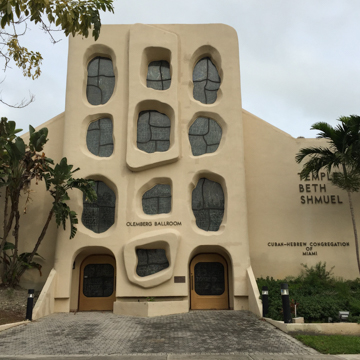Temple Beth Shmuel, home to the Cuban Hebrew Congregation of Miami, is a synagogue primarily used by Ashkenazi Jewish Cuban expatriates living in Miami Beach. The Cuban Hebrew Congregation was founded in 1961 to provide a sanctuary for Jews fleeing the Cuban Revolution of 1959. Many of the founding congregants (of what was at first called Circulo Cubano Hebreo de Miami or El Circulo) were the children of Jewish refugees from Europe, who had come to Cuba in the 1920s and 1930s, when the United States reduced the quota on Jewish immigrants.
The temple was designed by Oscar Sklar in 1982 and features a Neo-Expressionist entry facade with a dozen stained glass windows, each dedicated to an abstract representation of one of the twelve tribes of Israel. Artist Inge Pape Trampler designed the windows, as well as a large window in dalle de verre behind the bimah, the platform from which services are directed. Naomi Siegman, a Jewish Mexican artist, designed the menorahs (candelabras) flanking the bimah.
Sklar, a Cuban Jew and a member of the congregation, was inspired by what he called the cave-like spaces of the Old City of Jerusalem in creating the geomorphic forms of the entry facade. The facade resembles the priestly breastplate worn by Aaron in the Book of Exodus, with the stained glass windows taking the place of the twelve jewels representing the tribes of Israel. The reference to Exodus is particularly poignant for a congregation whose members had fled persecution in Europe and Cuba, and for whom religious belief provided social cohesion.
Ten of the twelve stained glass windows are set into irregularly shaped frames, several of which protrude in front of the facade, suggesting perhaps the distinct qualities of each of the twelve tribes. The other two windows are set into the entry doors. The placement of twelve unique (and uniquely inset) stained glass windows in the temple front also suggests the Cuban exiles’ hope that one day each of these unique tribes might one day be re-established; similarly, the Cuban exiles hoped to re-establish in some way the lives they had left behind in Cuba. Temple Beth Shmuel represents the abiding connection the congregants of El Circulo felt to their historical and religious past, and to their hope for a circling back or return to those better days.










